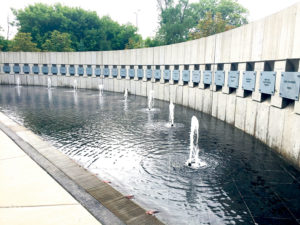If someone had asked me to list the three largest Holocaust museums in the world, I think I could’ve named the first two. The U.S. Holocaust Museum in Washington and Yad Vashem in Jerusalem are well known and receive millions of visitors every year.

Naming number 3 would have been tricky. No, it’s not in New York or anyplace in Europe. The third largest Holocaust museum in the world is situated in the pleasant, tree-lined Chicago suburb of Skokie, Ill.
Skokie has a large, well established Jewish community. But so do many other cities in North America. So why Skokie?
It turns out that one of the largest concentrations of Holocaust survivors in the world reside within the city.
READ: FACING A FUTURE WITHOUT SURVIVORS
It was Skokie’s overwhelming Jewish presence that resulted in a major legal battle in 1977. Led by neo-Nazi Frank Collin, the National Socialist Party of America applied for a permit to hold a rally through the city’s streets. With more than 7,000 survivors living in Skokie at the time, the Jewish community was outraged. Survivors galvanized in support of protesting the rally and fought the neo-Nazi group all the way to the U.S. Supreme Court. The First Amendment decision allowed the group to rally, but in the end it did so in Chicago.
The fight against the neo-Nazi rally ushered in the beginnings of American Holocaust studies. With this in mind, the village of Skokie opened the Illinois Holocaust Museum and Educational Center several years ago.
The imposing structure sits tucked away in a stone building that looks eerily similar to a prison. While walking up to the building, one gets a sense of doom as though approaching an execution.
After passing through extensive security, we came up to the desk where Holocaust survivor and museum volunteer Judy Kolb greeted us. Judy is just one of numerous survivors who work or volunteer for the museum.
Kolb shared her experience with us. Before the war, her father was a cantor in a German synagogue. Her family was forced to flee and lived in Shanghai for eight years before moving to the United States. Judy’s favourite red dress, one of her few possessions from that horrific time, sits prominently on display in the museum.
Upon entering the display rooms, the sense of approaching dread is magnified. The rise of the Nazi party and subsequent war years are dramatically illustrated with numerous artifacts and videos that rival both Yad Vashem and the Holocaust Museum in Washington.
READ: HOLOCAUST SURVIVORS’ TESTIMONIES GET DIGITALLY PRESERVED
What visitors only begin to notice as the visit continues are the subtle changes in lighting and flooring within the museum. With each subsequent display, the floor lowers nearly imperceptibly. The carpeting gradually gives way to tile and then brick style flooring. The lighting progressively dims and the walls seem to move in tighter. Visitors begin to feel the sense of dread that encompassed Europe during that time.
Only after the display on liberation and the subsequent founding of the State of Israel, do the floors and lighting return to normal. But the most amazing experience of the museum was yet to come.
Knowing full well that Holocaust survivors won’t be around much longer to share their stories, the Illinois museum has embarked on a most remarkable mission. One that not just tells survivors’ stories but allows future generations to actually converse with survivors.
READ: CREATING A HOLOCAUST CONVERSATION FOR THE FUTURE
Utilizing a profoundly advanced technology, the museum has partnered with the Shoah Foundation and a media design team from University Southern California in Los Angeles to test a pioneering new exhibit. Dubbed “New Dimensions in Testimony,” an interactive holograph of a Holocaust survivor is projected in a darkened room. Using a system similar to Apple’s SIRI, visitors speak into a microphone and can ask the survivor whatever they like. For most, it provides the feeling that one is speaking via Skype. The museum plans to have up to 17 survivors share their experiences using the technology within a few years.
The first survivor chosen to partake was Toronto’s Pinchas Gutter. Gutter was born in Lodz, Poland and survived the Warsaw Ghetto as well as six concentration camps. After living in South Africa for many years after the war, Gutter moved to Toronto where he was a part-time chazzan and lay chaplain at Baycrest.
In order to participate, Gutter was subjected to several days of interviews where he answered nearly 2,000 questions. More than 26 hours of his responses were recorded, detailing nearly every aspect of his life.
The remarkable interaction takes place on the museum’s lower level.
“What was Poland like growing up?” asks my 11-year-old son. Gutter responds that life was pleasant as a child until the war broke out. He recalled going to synagogue and praying with his father.
“What were the concentration camps like?” asks my 15-year-old. Gutter, overcome with emotion, recalled several horrific events that he experienced in the camps. He also shared several examples of how his quick thinking saved his life.
In his 2014 interview with The CJN about the project, Gutter stated “If this helps advance the knowledge of the Shoah in the future and it doesn’t just become an academic exercise, it is very meaningful.” With hundreds of visiting school children having already “spoken with” Gutter, the project’s tremendous meaning is evident.
Michael Stavsky acknowledges the assistance of Chicago’s North Shore Convention and Visitor’s Bureau in arranging his family’s visit to the Illinois Holocaust Museum and Education Center.









